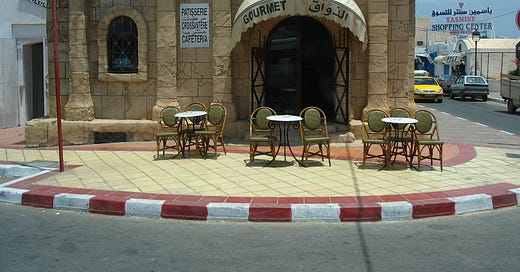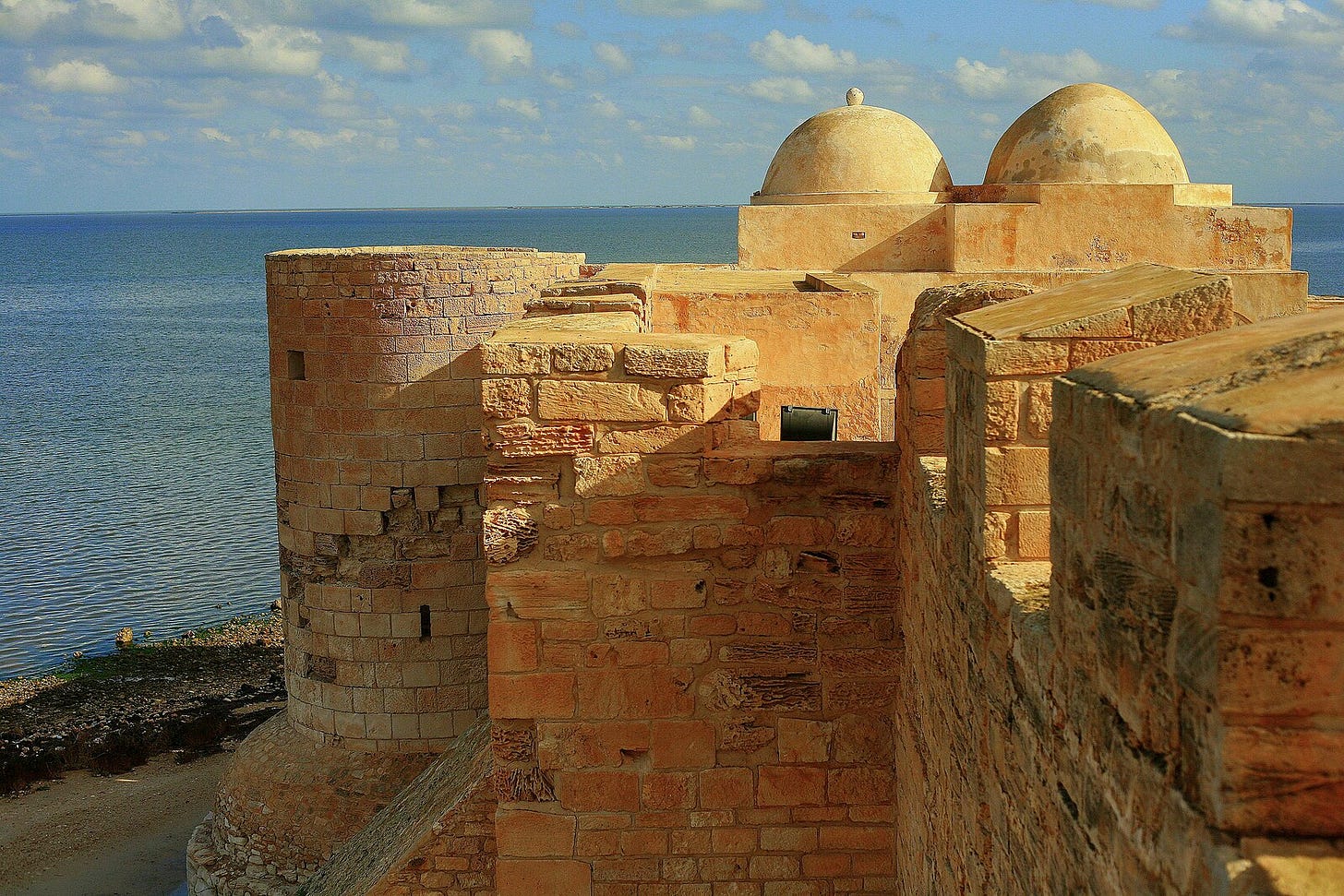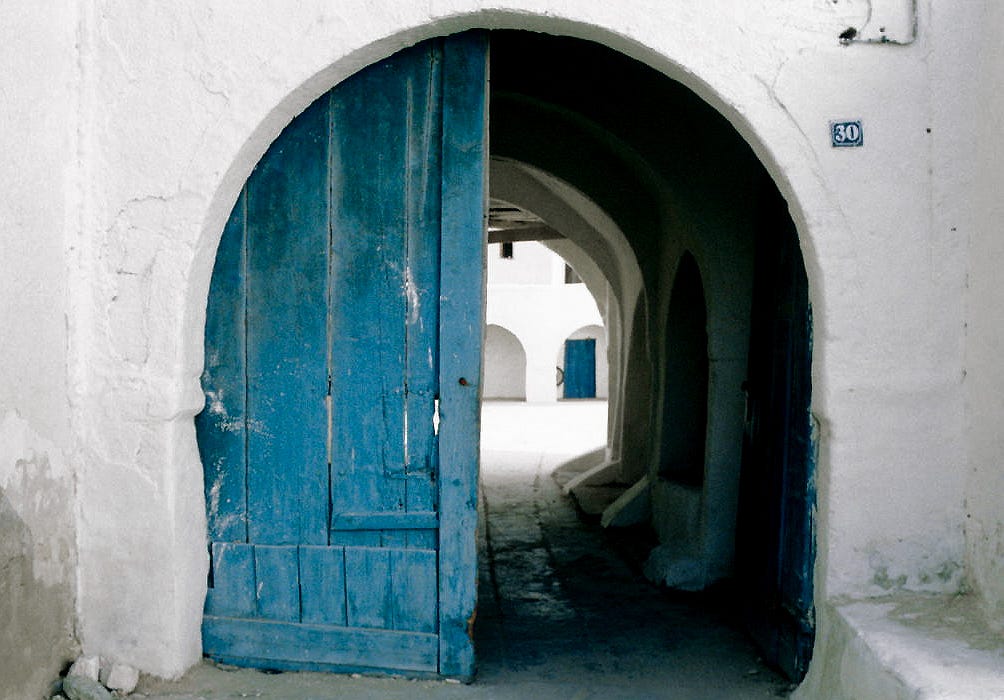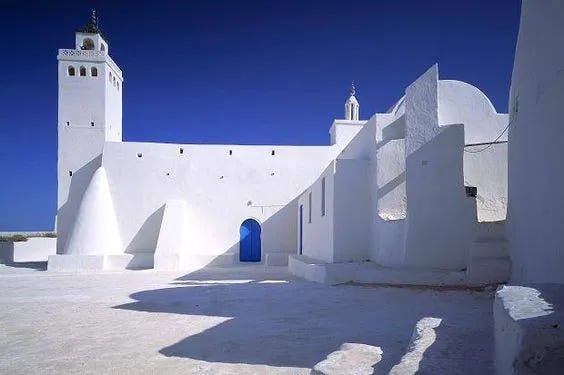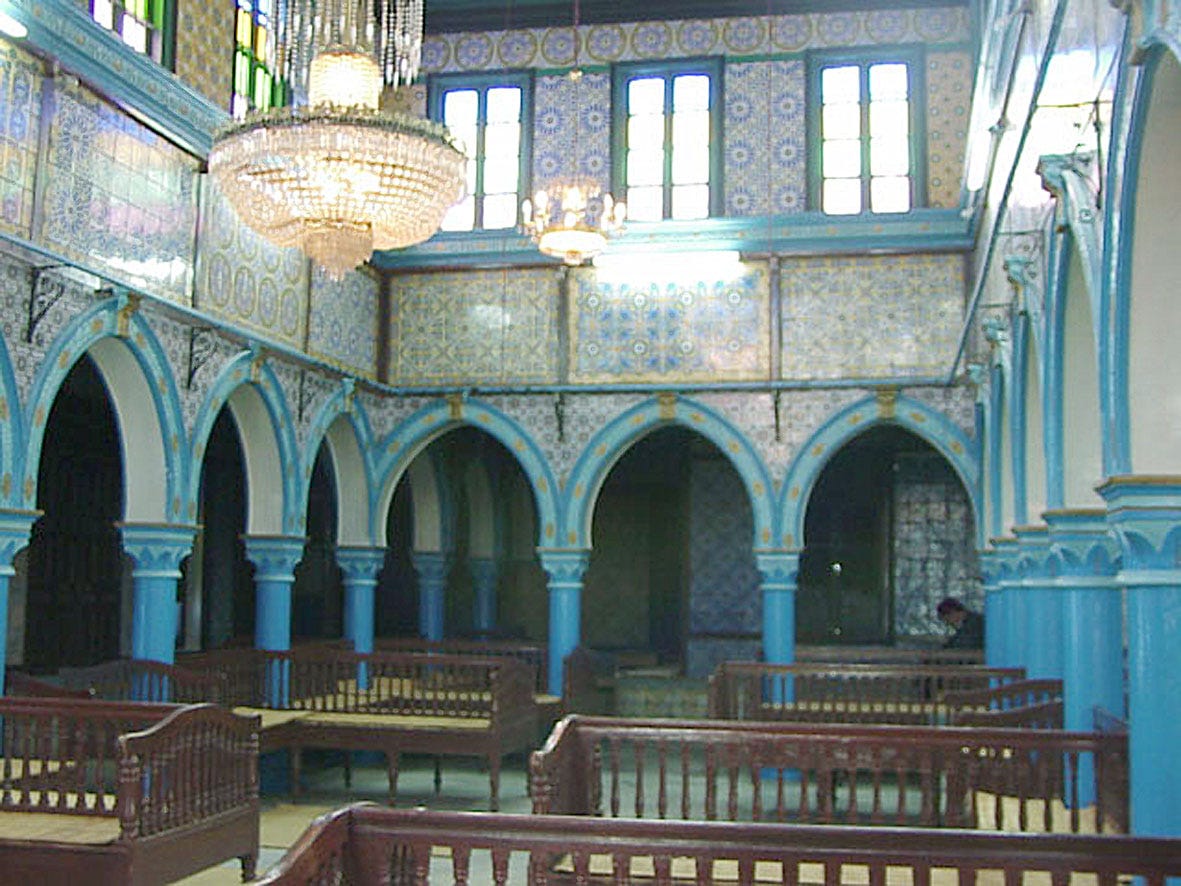Spirit of Place: In the Land of the Lotus Eaters [Updated May 10, 2023 with news of another terrorist attack on the island's synagogue]
Some say the Tunisian island of Djerba is where Homer's Odysseus encountered a drug-addled but happy population of islanders. Others, like the French, simply call it Djerba la douce.
“If you want to ride a camel, you must first get on.”
Looking back on it, I wonder if Jamel Mestaoui wasn’t quoting some Berber proverb, passed down through the generations like the other customs that govern life in his village on the island of Djerba.
Perhaps, when Jamel was a boy, his father would take him up to the Dhahret Adloun, the barren outcropping that rises above the whitewashed houses of Guellala and fill his young head with stories. From the top of the hill, the highest point on this Tunisian island, the pair might have gazed past the palm fronds undulating in the Mediterranean breeze, across the cobalt gulf to the North African mainland, while Jamel’s father recounted cruelties that the Turkish occupiers inflicted on the Berbers, or told him the tale of a miraculous mosque.
Yet from where I sat, Jamel’s good-natured comments seemed tailored to my predicament. They were certainly more helpful than the nonchalant snorts of Ali, the spirited young camel whose failure to cooperate had landed me on my butt in the warm Djerba sand.
Ali’s single brown hump loomed above me, silhouetted against the cloudless sky. His master, Jamel’s friend Ben Mimoun Slimen, grabbed the bit in the camel’s mouth and began hitting the animal with a stick so Ali would sit back down on his haunches and I could have another try. Ben Mimoun explained again that all I had to do was lean forward against the hump while grabbing the tufts of hair on the animal’s flanks, and then, up!
So far, this procedure had only put me in the approximate proximity of the camel, not square on its back where I wanted to be. I agreed to try one more time. With Jamel waiting to catch me on one side and two village boys shouting encouragement on the other, Ali suddenly sprang to his feet. Somehow I hung on. The camel shook his head as if to belittle my accomplishment, but he agreed to let Ben Mimoun lead him around while I clung to his hump and tried to look dignified.
Ali might not have been so smug had he realized that his breed is dying out on Djerba. Eighty years ago there were about 2500 dromedaries on the island. Now there are no more than several dozen. The Djerbans once valued these obstinate beasts as much for the flavor of their meat as for the work they performed, such as turning the huge screws of underground olive presses or pulling ropes that drew water-laden leather buckets from the island’s wells. Today the animals serve mostly to amuse the tourists. But the camel still takes part in the traditional Djerban marriage ceremony, conveying the bride to her husband in a jahfa, a platform canopied with colored silks.
Thus was Jamel’s wife, Faouzia, presented to him at their nuptials some years ago. When the jahfa was opened and Faouzia climbed down, the couple met for the first time, although they had long admired each other from afar. Unfortunately, I never got to meet Faouzia during my visit to Djerba, nor did I see their daughter who was born on the day I arrived on the island. Faouzia had followed the Berber custom and returned to her parents’s home for the week following the birth. No one outside the family could visit. For a stranger to enter would be, as Jamel put it in the French we spoke together, formellement interdit—strictly forbidden.
But nothing stopped Jamel—who worked as a nurse at the hospital and ran a pastry shop as well—from dropping everything to show me around the island. My protests were no match for Tunisian hospitality. Didn’t he want to spend time with his wife and children? Oh, there was plenty of time for that in the evenings. And, he added, hadn’t I been sent to Jamel by one of his childhood playmates who had left Djerba 20 yeas before to settle in France? Actually, the former playmate wasn’t really a friend but merely the client of an architect I knew in Paris.
No matter. “The friend of mine friend is my friend,” Jamel said. And that was that.
Djerba la douce, the French call it. Djerba the sweet, soft, gentle. When France invaded Tunisia on a flimsy pretext in 1881 and turned the country into a protectorate, its aims were no doubt more strategic than capturing a peaceful beach. Yet the white sands of this Mediterranean island, an oasis of dates, palms, and olive trees just off of southern Tunisia, went with the territory.
Until the 1960s, most visitors here were French, usually artists and writers seeking to bask in the glow of ancient civilizations or at least under the brilliance of an island sun. But when Tunisia gained its independence in 1956, international tourism began to flourish. Today dozens of resort hotels line the fine beaches of Djerba’s northeast. The French must now share the island with the throngs of Germans and Italians who arrive every summer.
Unlike islands that take fanciful shapes and rise like sunken mountains from the sea, Djerba has the outline of a giant molar, and its terrain is almost completely flat. It seems to float on the Gulf of Gabès like a mirage that could vanish at any moment beneath the waves. Its suface is only rarely thrown into relief, such as at Tanit, a promontory that rises in gray and white sedimentary rock above the island’s eastern coastline. The otherwise calm Mediterranean crashes furiously against this headland, as if it wanted to flatten Tanit as well.
As for the douceur that attracts thousands of visitors to Djerba each year, the secret is in the wind. From March to October the parched Sahara desert gasps in lungfuls of humid Mediterranean air, drawing sea breezes across the island from the east and northeast. These winds ripple through the sands day and night, rendering the islands air, as the French writer Gustave Flaubert once put it, “so soft that it hinders death.” Even when the wind reverses and the Sahara aims a fiery sirocco against Djerba’s shores, its flames are largely quenched by the waters of the gulf.
If the Greek myths are to be believed, in antiquity the island had other attractions. Scholars of The Odyssey pick Djerba as the most likely site of the Land of the Lotus-Eaters, where, according to Homer, the islands ate a fruit that kept them in a state of blissful indolence and forgetfulness. During his wanderings after the Trojan War, Odysseus and his men put ashore on the island. When a few crew members ventured inland and tried the fruit, Odysseus had to force them back to the ship and tie them up, because “all they now wanted was to stay where they were with the Lotus-Eaters, to browse on the lotus, and to forget all thoughts of return.”
Had the rest of Odysseus’s men known the perils that awaited them—from Cyclops to Circe—they too might have sat down in the sand and started munching the fruit.
These days an islander seeking forgetfulness need look no farther than the palm, whose sap, called legmi, is a popular beverage. Legmi tastes like pineapple juice, only stronger and sweeter. It is supposed to be imbibed soon after it is tapped from the tree, since it ferments rapidly—and alcohol is forbidden to observant Muslims. Apparently this rule is not always followed. I don’t know the vintage of the flask I shared with Jamel one day, but it certainly was a venerable brew.
Monday morning, seven o’clock. I was having breakfast on the terrace of the Cafe Ben Yedder in Houmt Souk, the island’s largest town. A light wind was blowing in from the sea, mixing hints of salt and seaweed with the aromas of coffee and jasmine that permeated the square. The throaty wine of mopeds from a nearby street echoed from the whitewashed walls and arched entryways of the surrounding shops, whose ornately carved blue doors were already thrown open to receive customers.
Mondays and Thursdays are market days in Houmt Souk, and it seemed that all of Djerba was passing by my table. Armed with my notes from a visit to the town’s museum, where traditional island attire was on display, I was ready. Three women walked by carrying baskets on their arms, each wrapped in an omejja, a robe made from alternating silk ribbons of cadmium red, black, and white, and wearing a vest of embroidered velvet, called a kurdia. They were obviously married Arab women from the town.
A young woman wearing a conical straw hat passed by, draped in yellow and vermillion checked cloth and a shawl made from similar material. Clearly, an unmarried Berber girl from Guellala.
A man in black Western-style slacks and white shirt emerged from the dim passageways of the covered market and started across the square. Like most older men on Djerba, he covered his head with a chechia, the red felt cap seen all over Tunisia. Yet he was wearing it on the back of his head rather than toward the front. That old me he was a Jew, probably a jeweler from a nearby village, selling his wares in the market.
On Djerba, ethnic groups whose fortunes have risen and fallen in the rest of North Africa continue to live closely—although not always easily—together. The Berbers were here first. But after the Arab conquest of North Africa in the seventh century A.D., and especially the invasion of other Arab tribes 400 years later, the Berbers took refuge in the more inaccessible corners of the land that once was theirs.
Among their sanctuaries was Djerba. Although Berber-speaking people make up less than one percent of Tunisia’s population, many remain on the island. Just how many is a mystery. It seems no one bothers to count.
“The Arabs want to forget we are here. They want us to disappear,” Jamel told me. Nevertheless, Berbers are still a majority in several villages, largely due to strictures against intermarriage. A Berber might marry an Arab in another town, Jamel said, but in Guellala such a pairing would be formellement interdit.
As for the island’s Jews, their claim is also an ancient one. According to tradition, Jewish settlement in Djerba dates to 586 B.C., the year that the Temple of Solomon in Jerusalem was destroyed by King Nebuchadrezzer II. More certain is the fact that today most of North Africa’s 20,000 Jews are assimilated into the life of large cities like Tunis, while the self-enclosed Jewish communities of Djerba cling in diminishing numbers to two villages on the island. They might be called the last of the Arab Jews.
“Don’t worry,” Jamel said, laughing at the jittery tone in my voice. “If it caves in, at least we will all die together.”
I seldom suffer from claustrophobia, but my tolerance was being tested. For 15 minutes we had been descending via a steep and narrow passageway into the bowels of Dhahret Adloun. My only reassurance was that the old man leading the way with a small flashlight, Ben Mimoun Mhenni, dug this tunnel himself over the previous 50 years. We were accompanied by a potter from Guellala named Younes and the two or three boys who always seemed to be at hand when a foreigner is being shown around.
Near the entrance at the top of the hill, the tunnel walls were made of hard rock. But as we went deeper I could feel them becoming alarmingly soft and moist. At last we reached a damp chamber, from which other passageways branched in various directions. Ben Mimoun, barefoot and dressed in a robe of brown burlap, led us down first one and then another. I stayed close to him and his flashlight.
Here, at the bottom of this mine, some 100 feet deep, Younes and many of Guellala’s other craftsmen harvest the clay from which they make their ceramics. Younes dug his fingers into a nearby wall and scooped out a gleaming handful. He said that this soft clay, a gray marl rich with gypsum crystals, is found nowhere else on Djerba. It is the secret behind the simple, unglazed pottery—bowls, jars, and oil lamps—that is famous not only in Tunisia but neighboring Algeria and Libya as well.
Back above ground, Jamel and I continued our tour of the island. We stopped at a modest whitewashed mosque called the Jamaa Ellile, the “mosque of the night.” It’s otherwise flat roof was topped with several small cupolas, and a round minaret rose from one corner of the building. On Djerba, Jamel said, you can tell who frequents a mosque by the shape of the minaret: If it is round, Berbers worship there; squared, Arabs.
There was no one in the mosque as Jamel pushed aside a flimsy wooden gate blocking the stairs to the minaret, and we would our way to the top. The island sands were spread out before us, dotted with swaying date trees.
“According to legend,” Jamel said, “when the workmen came to build the mosque they got everything ready—bricks, sand, and lime. Then they went to sleep, intending to start the next morning. But when they woke, the mosque was already built. It was a miracle. Ever since they have called it the mosque of the night.”
“Do you think the workmen got paid?” I asked
“Who knows?” said Jamel, laughing. “It’s a story our fathers and grandfathers told us. If I have a son one day, perhaps I will tell it to him.”
The sun was setting behind Cafe Ben Yedder, painting the white buildings of the square with a pink tint. The cafe was packed with men, young and old, drinking glasses of strong reddish tea or sipping from tumblers filled with a green liquid that smelled like anise. A group of old men shared the mouthpiece of an ornate silver hookah, taking turns bubbling the acrid smoke through a water-filled, darkly stained glass vessel. Except for a few tourists, there were no women.
I was at my usual table on the terrace, eating a brik, a Tunisian delicacy made from a thin pastry wrapped around a stuffing of meat or vegetables and a raw egg. It is then deep-fried and served hot and crispy, with the egg yolk still runny inside.
Four young Arabs came up to me and asked if they could share my table. They turned out to be students in Tunis who had returned to visit their families. We talked about cars, about Saddam Hussein, about music. I told them that my favorite singer was Van Morrison. They had never heard of him. Their favorite singer was Hedi Habbouba. I had not heard of him either.
One of them pulled out a crumpled piece of paper with the words from Bob Marley’s “I Shot the Sheriff” written out in pencil. Could I explain what the song meant? It was quite a challenge.
Sing it, they said, we want to hear how it should sound.
“I shot the sheriff, but I swear it was in self-defense,” I sang. They joined in. “I shot the sheriff, and they say it is a capital offense.”
To someone passing by, the spectacle of four Tunisian Arabs and a middle-aged Jewish Westerner singing a reggae song must have been a strange sight. But it seemed perfectly natural at the time.
To an outsider, the cluster of white houses surrounded by orchards and olives trees looks like any other village in southern Tunisia. Even a stroll through Hara Sghira’s shaded alleyways might fail to reveal the unadorned entrances to the village’s five synagogues, all five now closed. The tour buses seldom stop here. They continue along the half mile of dusty road to a sixth synagogue, called the Ghriba (in Arabic, the “strange and marvelous”), where the local Jews come to pray and where Jews from all over North Africa come on an annual pilgrimage.
I arrived for Saturday prayers, which began promptly at eight in the morning. When I stepped into the Ghriba—a modest white building on the outside, but adorned with vivid blue tiles and hanging silver oil lamps on the inside—I was surprised to see that there was barely a minyan, the ten men needed to conduct the service. Though I had heard that the Jews of Djerba were strict in their observances, the service seemed relaxed and good-humored. The worshippers, wearing white prayer shawls, lounged casually on straw mats thrown over the benches of the synagogue, sometimes chatting together as the rabbi chanted from the raised wooden platform in the center of the tabernacle.
When the service was over, the men gathered outside the synagogue, talking and laughing. Eliahu Cohen, the Ghriba’s young rabbi, invited me for lunch at his home.
The wind had died down, and the sun beat hard on our heads as we walked down the lane to the village. Cohen led me across a courtyard, through a curtained entryway, and into a small room. The whitewashed walls were covered with red-and-white tapestries. As we sat together on a straw mat in front of a wooden table, the rabbi’s mother, smiling but silent, served us a barley and lamb stew, accompanied by Arab bread and fruit.
Rabbi Cohen, who told me that his family has lived on the island for 25 generations, showed me four leatherbound volumes that contained all the laws and regulations governing the lives of the island’s Jews. Printed in Judeo-Arabic, the books used Hebrew letters to transcribe the Tunisian dialect that his congregation spoke.
In 1946, the combined population of the island’s two Jewish communities, Hara Sghira (“Small Village”) and Hara Kebira (“Large Village”) had peaked at 4,300. But events since then—the establishment of Israel, the independence of Tunisia, two Arab-Israeli wars—had triggered waves of emigration, mostly to Israel. At the time of my vist, only 700 Jews remained on Djerba, Cohen said.
The rabbi seemed happy to answer most of my questions. But once he looked away with tears in his eyes and did not respond—when I asked if he thought it possible that one day the Jews might disappear from Djerba altogether.
My last evening on the island, Jamel and Younes invited me to dinner at Younes’s pottery studio in Guellala. The crumbling stone arches of this underground room, which had been built at least 300 years ago, were propped up with piles of broken clay jars and bits of stone. The air was quite cool, ideal for allowing the pottery to dry slowly before it was fired in the kiln. Jamel lent me his blue Berber robe to wear.
Jamel and Younes made a small fire of olive branches and began preparing the meal: roast fish Berber style. The fish—grouper from the market—were slit, cleaned, and then rubbed with a mixture of salt and cumin. Alternating layers of fish and palm fronds were laid in a large round casserole Younes had made, which was then covered tightly and sealed with clay. After about 20 minutes, the pungent aroma of cumin filled the room.
We ate the fish with our hands—effoise, the Berbers say, with five fingers—and drank Tunisian beer. As often happens when men get together, the conversation turned to women. Was it really true, I asked, that on Djerba it is not proper for a man to have a conversation with a woman in public? That depends, they said. If she is in traditional dress, it is not allowed. If she is in Western dress, it might be permitted.
“This is very difficult for a Westerner to accept,” I said. “I feel as though I am cut off from half the people on the island.”
Jamel replied, “In the north of Tunisia, life is more Europeanized. In Tunis women work in offices and go together to cafes. But here we stay with the old ways. Men and women have different roles. Can you give birth to a baby? Of course not. In Europe all the women work, and the children only see their parents for an hour or two each day. No wonder there is so much divorce.”
“Yes,” I said, “but since your wife isn’t working, can she take your daughters and go sit in a cafe with the men?”
Jamel and Younes looked at each other. Jamel smiled.
“Not in Guellala,” he said. “That would be formellement interdit. But perhaps the next generation will be allowed to do things that were forbidden to us.”
It was well after midnight when we said goodbye. I drove the long way back to my hotel, along Djerba’s west coast. The toy camel Jamel had given me to take home to my young daughter was perched on the passenger seat. The wind was blowing hard, bending the palm trees in the moonlight. The surf gurgling in the tide pools of the rocky shores sounded like a child splashing in a bathtub.
I’ve never known an island that was easy to leave. Perhaps that’s because every island confronts us with a choice—to return to our homes on the mainland, or stay and live forever among the Lotus-Eaters.
Note: This is an adaption of an article I published in 1993 in Islands magazine, where I was a contributing editor for a number of years under the brilliant editor Joan Tapper. Younes moved to Metz, a city in the east of France, some years ago, and we still keep in touch via Facebook. Jamel still lives on the island with his family. The Jews of Djerba continue to thrive; some reports now put their number as high as 1000.
Update May 10, 2023: Very sadly the Ghriba synagogue has been the site of a mass shooting that killed five. This is far from the first time the Jews of Djerba and visitors to the site have been attacked. In 2002 a terrorist attack killed 19 people.

